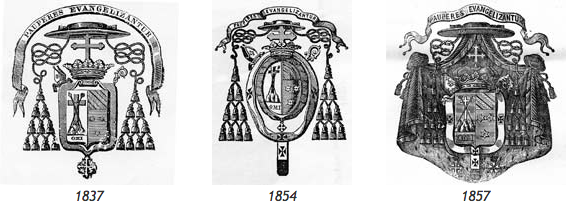Already in a letter to his father dated October 18, 1799, Eugene spoke of his armorial bearings. “I know,” he wrote, “that the magistrate’s mantle and bonnet are not the features of my coat of arms.” They were, in fact, those of his father who, before the Revolution, was president of the Court of Accounts, Aid and Finances.
The question of his coat of arms re-emerged during Eugene’s seminary days. He recalls it in his diary entry of March 31, 1839: “Elegi abjectus esse in domo Dei mei. [I have chosen to be cast aside in the house of my God.] That was my motto. My armorial bearings were drawn above my father’s président à mortier mantle, taken off and carelessly thrown over a stone bench and the judge’s cap along with the count’s coronet reversed; a wooden cross and a crown of thorns rise above this armorial design, taking the place of those ornaments I swore to renounce by trampling them, as it were, underfoot. There you have the secret of my vocation illustrated perfectly. (LEFLON, J., Eugene de Mazenod, trans. Francis D. Flanagan, o.m.i., vol. I, p. 308)
The coat of arms of Bishop de Mazenod, bishop of Marseilles, appeared on his first pastoral letter on December 25, 1837. They were made up of the coat of arms of the Congregation of the Oblates and that of the Mazenod family. According to the technical terms of the science of heraldry the coat of arms is made up as follows: “In the first quarter, blue with the Oblate coat of arms; second quarter blue with three golden rowels, the upper quarter, gold with three red bands.” Framing it on either side are seen four rows of tufts (signs of the cardinalate) and above a ducal crown. It was Bishop Etempes who put these features in his coat of arms in 1680 and his successors did likewise. Surmounting the whole we read the motto: Pauperes evangelizantur and below appear the cross of the knight of the Order of Saints Maurice and Lazarus which Father de Mazenod received on January 13, 1827. In a letter to Father Courtès dated January 7, 1838, Bishop de Mazenod explained his coat of arms as follows: “You will notice that I have not disowned my position as Founder and superior of our beloved Congregation. … I did combine its coat of arms with that of my family, and you will notice the missionary cross shining brighter than my own coat of arms, and the motto so precious which is distinctive of this Society above everything. You will explain it to whomever wishes to listen, no beating around the bush in this matter. This is a coat of arms that speaks.” (Oblate Writings I, vol. 9, no. 656, p. 81)
A few details were added later on. We see featured the pallium granted to Bishop de Mazenod and his successors by Pius IX on April 1,1854, under certain conditions and restricted to the territory of the diocese of Marseilles. In 1857, two crosses were added: the cross of the Order of the Imperial Legion of Honour of which Bishop de Mazenod was named an officer by decree of August 11, 1855 and the cross of the Commander of the Order of Saints Maurice and Lazarus which he received on January 13, 1856.
Yvon Beaudoin, o.m.i.

